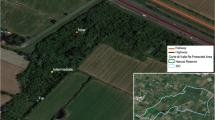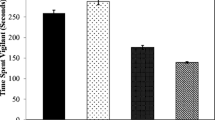Abstract
In this study the distance, at which polar bears detected and actively responded to approaching snowmobiles was measured and the behavioural response was recorded. The study was performed on Svalbard, an arctic island where human traffic has increased substantially in recent years. Fieldwork was conduced in April and/or May during the years 2003–2005. Polar bears were observed on ice with telescopes and binoculars. Undisturbed polar bears were observed continuously and their behaviours recorded, during the time when two snowmobiles moved toward the bear(s). Distances between the bear, the observer, and the approaching snowmobiles were measured using GPS positions taken on the track towards the bear. Data on the behavioural response of 20 encounters with bears were collected. On average, bears were alerted to the snowmobiles at 1,164 m. Mean distance at which the locomotive response occurred was 843 m, and there was a statistical significant difference in distance between sex and age classes [326 m (95% CI = 138–496 m) for adult males; 1,534 m (95% CI = 508–2,768 m) for adult females with cubs; 164 m (95% CI = 49–543 m) for two adult females without cubs; and 1,160 m (95% CI = 375–1,353 m) for single medium sized bears]. The responses of the polar bears to the snowmobiles were categorized according to intensity and persistence of reactions. Females with cubs and single medium sized bears tended to show more intense responses than adult males and lone adult females. Wind direction affects sound and odour transmission, and although an effect on response distance was not found, the response intensity was affected by wind direction. We conclude that female polar bears with small cubs in particular may have a greater risk to be disturbed, since they react at greater distances with amplified reactions; thus, users of snowmobiles should take particular care in areas where females with cubs are present.
Similar content being viewed by others
References
Aars J, Lunn NJ, Derocher AE (2006) Polar bears: proceedings of the 14th working meeting of the IUCN/SSC Polar Bear Specialist Group, 20–24 June 2005, Seattle. IUCN, Gland, Switzerland and Cambridge, UK
Amstrup SC (1993) Human disturbance of denning polar bears in Alaska. Arctic 46:246–250
Babb TA, Bliss LS (1974) Effects of physical disturbance on arctic vegetation in The Queen Elisabeth’s Islands. J Appl Ecol 11:549–562
Blix AS, Lentfer JW (1992) Noise and vibration levels in artificial polar bear dens as revealed to selected petroleum exploration and developmental activities. Arctic 45:20–24
Born EW, Riget FF, Dietz R, Andriachek D (1999) Escape responses of hauled out ringed seals (Phoca hispida) to aircraft disturbance. Polar Biol 21:171–178
Calef GW, DeBock EA, Lortie GM (1976) The reaction of Barren Ground Caribou to aircraft. Arctic 29:201–212
Chapin III FS, Shaver GR (1981) Changes in soil properties and vegetation following disturbance of Alaskan arctic tundra. J Appl Ecol 18:605–617
Colman JE, Jacobsen BW, Reimers E (2001) Summer response distances of Svalbard reindeer (Rangifer tarandus platyrhynchus) to provocation by humans on foot. Wildl Biol 7:275–283
Creel S, Fox JE, Hardy A, Sands J, Garrott B, Peterson RO (2002) Snowmobile activity and glucocorticoid stress responses in wolves and elk. Conserv Biol 16:809–814
Derocher AE, Wiig Ø, Andersen M (2002) Diet composition of Polar Bears in Svalbard and the Western Barents sea. Polar Biol 25:448–452
Dunnet GM (1977) Observations on the effects of low-flying aircraft at seabird colonies on the coast of Aberdeenshire, Scotland. Biol Conserv 12:55–64
Dyck MG, Baydack RK (2004) Vigilance behaviour of polar bears (Ursus maritimus) in the context of wildlife-viewing activities at Churchill, Manitoba, Canada. Biol Conserv 116:343–350
Eckstein RG, O’Brien TF, Rongstad OJ, Bollinger JG (1979) Snowmobile effects on movements of White-tailed Deer: a case study. Environ Conserv 6:45–51
Eid PM, Prestrud P, Eide NE (2001) Menneskelig forstyrrelse av fjellrev, rein og sel. Forrapport til Sysselmannen på Svalbard (In Norwegian) 6 pp
Freddy DJ, Bronaugh WM, Fowler MC (1986) Responses of mule deer to disturbance by persons afoot and snowmoliles. Wildl Soc Bull 14:63–68
Gabrielsen GW, Smith EN (1995) Physiological responses of wildlife to disturbance. In: Knight RL, Gutzwiller KJ (eds) Wildlife and recreationists. Coexistence through management and research. Island, Washington, DC 95–107
Kelly PB, Burns JJ, Quakenbush LT (1988) Responses of ringed seals (Phoca hispida) to noise disturbance. In: Port ocean engineering under arctic conditions. Vol. II. Sackinger WM, Jeffries MO (eds) Symposium on noise and marine mammals, August 1987. University of Alaska, Fairbanks. p 27–39
Lunn NJ, Schliebe S, Born EW (2002) Polar Bears: proceedings of the 13th working meeting of the IUCN/SSC Polar Bear Specialist Group, Nuuk, Greenland. IUCN, Gland Switzerland and Cambridge. Vii + 153 pp
MacArthur RA, Johnston RH, Geist V (1979) Factors influencing heart rate in free-ranging bighorn sheep: a physiological approach to the study of wildlife harassment. Can J Zool 57:2010–2021
Mauritzen M (2002) Patterns and processes in female polar bear space-use. Ph.D. Thesis, University of Oslo, Norway
Mauritzen M, Derocher AE, Wiig Ø (2001) Female polar bear space use strategies in a dynamic sea ice habitat. Can J Zool 79:1704–1713
McLaren MA, Green JE (1985) The reactions of muskoxen to snowmobile harassment. Arctic 38:188–193
Overrein Ø (2002) Virkninger av motorferdsel på fauna og vegetasjon: Kunnskapsstatus med relevans for Svalbard (In Norwegian). Norsk Polarinstitutt Rapportserie 119. 28pp
Prestrud P, Stirling I (1994) The international polar bear agreement and the current status of polar bear conservation. Aquat Mamm 20:113–124
Stirling I (1974) Midsummer observations on behavior of wild polar bears (Ursus-maritimus). Can J Zool 52:1191–1198
Tyler NJC (1991) Short-term behavioural responses of Svalbard reindeer (Rangifer tarandus platyrhyncus) to direct provocation by a snowmobile. Biol Conserv 56:179–194
Øritsland NA (1970) Temperature regulation of the polar bear (Thalarctos maritimus). J Comp Biochem Physiol A 37:225–233
Acknowledgments
This project was funded by The Governor of Svalbard and the Norwegian Polar Institute. We would like to thank Petter Wabakken and Øystein Overrein for their assistance in the field and for constructive discussions, and Audun Stien for helping in statistical analyses. We would also like to thank the anonymous reviewers for comments and suggestions that greatly improved the manuscript.
Author information
Authors and Affiliations
Corresponding author
Rights and permissions
About this article
Cite this article
Andersen, M., Aars, J. Short-term behavioural response of polar bears (Ursus maritimus) to snowmobile disturbance. Polar Biol 31, 501–507 (2008). https://doi.org/10.1007/s00300-007-0376-x
Received:
Revised:
Accepted:
Published:
Issue Date:
DOI: https://doi.org/10.1007/s00300-007-0376-x




